History of the Root Cellar
More than 40,000 years ago, native Australians began storing their yams underground as a way to take advantage of the cooling subterranean properties of the earth.
These principles fueled the invention of the root cellar as a way to store fruits and vegetables — most likely in 17th century England.
You May Also Enjoy:
“5 Easy Ways to Preserve Your Fresh Eggs”
The early colonists who arrived in North America from the United Kingdom brought this storage system with them, as evidenced by the thousands of old root cellars in the eastern half of North America.
In fact, the small town of Elliston in Newfoundland considers itself the Root Cellar Capital of the World. It has more than 135 root cellars, some dating back 200 years.
Let’s see how this ancient method of food storage can work for us today.
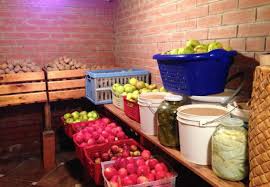
Source: http://www.lushome.com/root-cellar-designs-eco-friendly-natural-cold-storage-solutions/159282
What Is a Root Cellar?
A root cellar is a structure that is underground or partially underground and is used for the storage of vegetables, fruits, nuts, and other foods. Traditionally, the focus has been on storing root crops in an underground cellar (or basement).
Root cellaring is important in many places because it helps preserve the winter food supply. Modern-day food distribution systems and refrigeration make root cellars unnecessary for many people. However, they remain important for those who value self-sufficiency, whether out of economic necessity or by choice.
A great low-cost, no-energy way to store food and extend the shelf life of fresh produce, root cellars require very little maintenance. Some people build a root cellar at the same time that they’re building a home; some add a root cellar to their property at other times.
Essential Elements
Besides the building itself, there are four essential elements to include in every root cellar:
- Ventilation
- Earth Shelter (Either in the basement of your home or buried outside)
- Darkness
- Humidity
Ventilation: Keep the Air Moving
One of the key features to add to your root cellar are vents that allow air to enter and exit. These vents allow for temperature adjustments. The air circulation also helps with the ethylene gases and odors produced by your stored fruits and vegetables.
You’ll want at least one intake vent and one outlet vent. That being said, there are many situations in which multiple vents would be even better. In general, place intake vents low to the ground and outlets close to the ceiling. The vents create a nice, passive air flow through your root cellar.
Seal around the vents where they meet the building so that they can be closed tightly during the winter. Some people seal them with packed cloth, expanding foam, or tight rubber gaskets.
During the heat of summer, keep the vents open.
An additional option would be to add vent pipes that twist around to catch cooler or warmer winds.
Inside the cellar, arrange the shelves with a lot of space between them. This includes the storage closest to the floor, which should be raised a few inches. Similarly, the back of the shelves should be a few inches away from the walls to increase air circulation.
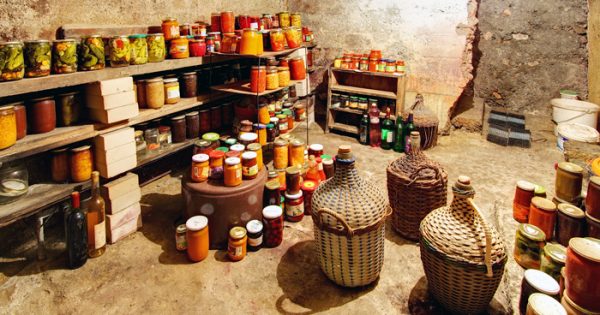
© TTstudio
Earth Shelter: Keeping It Cool
The whole reason for a root cellar is to keep food cool. A well-insulated root cellar should keep the food inside 40 degrees cooler than the average summertime temperatures outside. During the winter, the cool temperature maintains food at a temperature just above freezing, which slows deterioration and rot.
Temperatures in your basement are noticeably warmer, so food stored inside the house tends to spoil much more rapidly than food stored in an outdoor root cellar. Temperatures above 45°F cause toughness and sprouting, which leads to rapid spoiling.
A root cellar’s temperature is not uniform. The temperature near the ceiling is 10 degrees warmer than in the rest of the cellar. This area makes the ceiling area perfect for onions, garlic, and shallots.
In warmer climates that don’t tend to experience freezing temperatures during the winter months, root cellars are much less common. Still, there may be some viable mass-scale winter storage options. Check with your local extension office for suggestions.
Darkness: Lights Out!
Except for the occasional artificial light you’ll need to search through stored food, your root cellar should be as dark as possible. Sunlight causes stored fruits and veggies to deteriorate. Potatoes start sprouting when exposed to light.
Humidity
Humidity is an important factor in a typical root cellar. You’ll want to keep a humidity gauge, called a hygrometer, in your root cellar. Most fruits and vegetables require high humidity to stay fresh. If your underground root cellar has an earthen floor, it will naturally maintain high humidity.
Keep in mind, though, that humidity in your root cellar can cause a lot of problems if you are storing canned goods, nuts, or dehydrated fruits there. Fruits can rot, and metal canning lids may rust.
Once you decide what you’ll be storing, you might find you need a root cellar with both a humid chamber for fresh fruits and veggies and a dry chamber for other goods.
If you need to increase the humidity, try some of these tips:
- Sprinkle water on your gravel floors
- Pack vegetables in damp sawdust, leaves, or sand
If you need to lower the humidity, try these tips:
- Use a concrete floor
- Keep barrels of rock salt
- Allow more ventilation (drier air) to enter from outside
Drainage is necessary to help regulate humidity. While you want some humidity, you don’t want a slippery floor or dripping walls. Too much water causes a whole host of problems. Your stored produce should never come into contact with water, or it will rot. Use a humidifier and dehumidifier to regulate humidity extremes and water issues.
Build a Root Cellar
There are a lot of root cellar designs. Do a quick search on the Internet for root cellars, and you’ll have your pick of favorites.
The traditional style is dug into a hillside. Some of the modern versions are dug down into flat ground. Simple and inexpensive root cellars can be built from barrels, garbage cans, or refrigerators and freezers.
While you’re picking out a design, keep the following considerations in mind:
- As little as one foot of earth above the root cellar can create a temperature 20 degrees less than the average summertime temperatures above ground. Ideally, though, you’ll want a full 10 feet of soil above and beside the root cellar to ensure temperature stability.
- During the day, keep the doorway and any exposed parts of the structure in the shade at all times. The north side of a hill is an ideal place to build a root cellar.
- Next, you’ll want to make sure that your root cellar doesn’t suffer from leaks or drainage issues during rains. You may need a sloped door, drainage ditches outside, or gravel on the floor.
- Now it’s time to plan the size of your root cellar. Generally speaking, an 8-ft. by 8-ft. space will give you plenty of storage for an average family. Smaller structures are easier to insulate and to keep at an even temperature.
- Be sure to use waterproof and chemical-free wood in your construction. Your stored food may pick up the odors of weather-proofed and treated woods. Bricks or concrete blocks used in the construction will help you avoid this problem.
- Remember that proper ventilation is a must! Run a smoke test to make sure the intake and outflow vents are moving the air through the cellar.
- Finish off your root cellar with a thermometer and humidity gauge. You’ll never have to wonder about the temperature or humidity in your root cellar.
Root Cellar Lighting
Light exposure is the enemy of good food storage.
People spend hours canning their harvest and line up their beautiful jars on open shelves. It looks fantastic, but the light is bleaching the color and nutrients out of the food.
In the root cellar, light exposure may lead to sprouting and green potatoes. A burlap sack or fabric pulled over your potatoes or fruit allows ventilation but still blocks the light.
A single incandescent light should provide adequate lighting (unless your room is huge). If for some reason your storage gets too cold, use the light to introduce a little warmth.
5 Different Root Cellars You Can Build
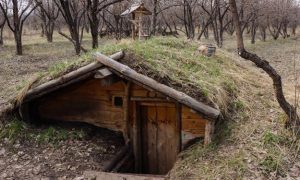
Source: http://www.lushome.com/root-cellar-designs-eco-friendly-natural-cold-storage-solutions/159282
Underground Root Cellar
This root cellar is a traditional in-ground root cellar. It is fairly well hidden and offers a lot of storage for your fruits and vegetables. As a bonus—it can double as a storm shelter.
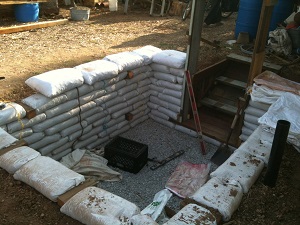
Source: https://www.motherearthnews.com/real-food/root-cellaring/the-earthbag-root-cellar-part-one-zbcz1411
Earthbag Root Cellar
Earthbag root cellars are another great in-ground root cellar. Instead of having walls built from cinder block, these walls are built from earthbags. You can find the polypropylene bags online. The materials for this build are very economical, and instructions are all over the Internet.
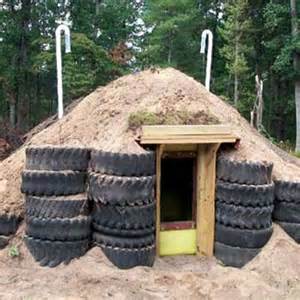
Source: https://www.pinterest.com/pin/402298179193873835/
Recycled Material Root Cellar
This creative project is not only a root cellar but also an above-ground storm shelter. Recycling material is good for your wallet and good for the Earth. That’s a win-win!
The other bonus with this project is that it is completely sealed, which means no spiders, snakes, or mice.
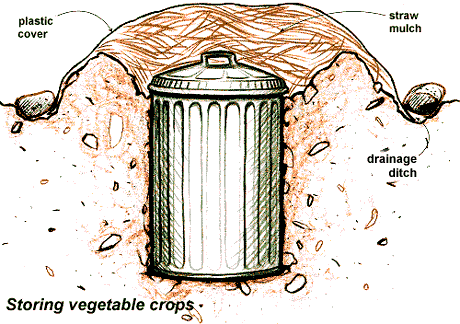
Source: http://101waystosurvive.com/survail_tips/trash-can-root-cellar/
Garbage Can Root Cellar
Bury a galvanized garbage can in a well-drained location. Make sure the can has a tight-fitting lid. Cover the lid with straw, and cover the straw with a waterproof canvas or plastic tarp.
Place the veggies and fruits in perforated polyethylene bags to avoid bruising and rot. Put root crops in this type of storage in late fall, and don’t put the carrots next to the apples. Also, sweet potatoes don’t do well in this kind of root cellar.
This idea is very economical and easy-to-build.
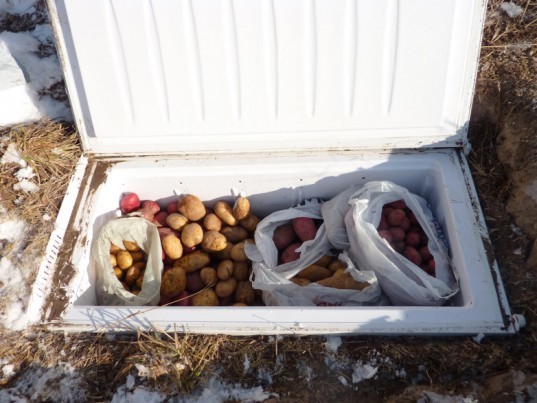
Source: https://inhabitat.com/diy-building-a-root-cellar-from-recycled-materials/
Buried Fridge or Freezer
Do you have a fridge or freezer that doesn’t work anymore? It would make a great root cellar. They have a lot of room and are already insulated. There are even plans on the Internet to create ventilation for these units. Make sure that the freon doesn’t leak into the ground. Do some research to find out how to prevent this.
Shipping Container Root Cellar
Another win for Mother Earth! Shipping containers can be found all over the world, and they’re made of high-quality steel that withstands wind and is expected to last for 50 years or more. They come in many different sizes to meet your needs.
Dig a hole into a hill and place the shipping container in it. Make sure it is properly ventilated and in an area with good drainage. If you have a problem with excess moisture, place an Absorpole inside a container to absorb moisture.
What Do You Store in a Root Cellar?
What can you store in your root cellar once it’s built? You may have visions of the 19th-century root cellars, packed with bushels of apples and sacks full of potatoes. Modern-day root cellars are not much different.
Ethylene Producers
A root cellar should have a lot of shelves, some higher than others and some closer to vents than others. Placing ethylene producers (see the list below) up high and nearer the outtake vents moves harmful gases away from other produce stored on lower shelves or the floor.
Fruits and vegetables that produce ethylene gas include:
- Apples
- Apricots
- Avocados
- Bananas
- Blueberries
- Cabbage
- Cantaloupe
- Chinese cabbage
- Citrus fruits (except grapefruit)
- Cranberries
- Figs
- Guavas
- Grapes
- Green onions
- Honeydew
- Kiwi
- Mangoes
- Melons
- Mushrooms
- Nectarines
- Okra
- Papayas
- Passion fruit
- Peaches
- Pears
- Peppers
- Persimmons
- Pineapple
- Plantains
- Plums
- Prunes
- Quinces
- Tomatoes
- Watermelon
Fruits and vegetables that may be damaged by ethylene gas include:
- Asparagus
- Broccoli
- Brussels sprouts
- Cabbage
- Carrots
- Cauliflower
- Chard
- Cucumbers
- Cut flowers
- Eggplant
- Endive
- Escarole
- Green beans
- Kale
- Leafy greens
- Lettuce
- Parsley
- Peas
- Potatoes
- Spinach
- Squash
- Sweet potatoes
- Watercress
- Yams
Root Crops
Store root crops in boxes of loose soil or sawdust, which insulate them from gaseous emissions. Cabbages and onions emit odors that taint the flavors of other fruits and vegetables, so find a high, remote corner for these smelly items.
Other Foods
In addition to storing raw produce, root cellars are perfect storage spaces for wine, cider, and beer. Cured meats like ham, bacon, and smoked meats, as well as milk, cream, butter, and cheeses store very well in temperatures below 40°F.
Grains and nuts store very well in root cellars, but containers must be sealed well to prevent an insect infestation. Dried and canned foods also keep well, but must be kept in a less humid cellar or in a separate, drier compartment in the same cellar.
How to Store Fruits and Vegetables in a Root Cellar
Fresh vegetables and fruits last different lengths of time when stored in a root cellar, but potatoes and apples last the longest. Other good keepers include garlic, cabbage, beets, kohlrabi, onions, winter squashes, pumpkins, and turnips.
Beans, nuts, and dried peppers are very long keepers, too.
Store onions and garlic on higher shelves that are warmer and dryer. Storing in trays allows for proper ventilation. Also, if an onion goes bad, it can be spotted and immediately removed before it spoils the whole batch.
Place potatoes close to the floor where it is cooler and moister (but not wet, because too much moisture will cause rot). Cover them with burlap to block out the light but still allow ventilation and prevent green potatoes.
Place a few cabbages on the top shelf. Pumpkins and squash go on the floor of the canning pantry or the top shelf in the root cellar. They like it a little warmer and drier.
Store your vegetables in buckets, bins, or boxes packed with lightly dampened leaves, sand, or sawdust. See which one works best for you.
14 Root Cellaring Tips for Success
- Rodents are a common pest problem for food stored in root cellars. Installing metal wire mesh at entry points, such as vents, is a good idea. Make sure all jars and containers are fitted with airtight lids. Keeping the area clean will go a long way toward preventing pest problems. If you have a problem with rodents, consider hanging storage instead of letting the produce sit on the ground.
- Rot is another common problem. Remember the old saying that “one bad apple will spoil the whole bunch?” Well, it’s true! Check your root cellar regularly. Be sure to remove any spoiled produce or other foodstuff.
- Lower temperatures combat the mold and bacteria problems that are common in warm, wet conditions.
- If you store nuts or grains in the cellar, insects may be a problem. DO NOT use an insecticide (for many reasons)! It could contaminate a lot of your stored food. Bay leaves or other strong herbs help deter insects safely.
- Late-maturing crops store better in a root cellar.
- The odor of strong-smelling vegetables, like turnips and cabbage, can be absorbed by other fruits and vegetables. Store them away from other foods and near the outtake vent.
- Do not allow fruits and vegetables to freeze. They will get mushy and rot.
- Store only perfect produce in your cellar. Do something else with damaged fruits and vegetables, like canning or dehydrating.
- Store produce just like it came out of the ground (soil, roots, and stems intact). Gently rub off the soil, but do not scrub or wash them. Remove the leaves of beets and carrots.
- Use the smallest produce and any slightly marked produce first and work toward the largest as you use up your stores.
- Before harvesting, a touch of frost on beets, Brussels sprouts, cabbage, turnips, rutabagas, pumpkins, and horseradish makes them store better and increases the flavor.
- Shock harvested onions into dormancy. About one month before harvest, break or bend the stalk. It will stop the root from feeding the plant.
- One problem with high-humidity root cellars is that sometimes the air will condense. If the condensation drips off of the ceiling and onto produce, the affected fruits and vegetables will rot. Pretreat the ceiling with a disinfectant, like chlorine, to slow the transmission of diseases spread by the dripping water.
- In very cold climates, you may want a second door to insulate the cellar.

The Grow Network is a global network of people who produce their own food and medicine. We’re the coolest bunch of backyard researchers on Earth! We’re constantly sharing, discovering, and working together to test new paths for sustainable living—while reconnecting with the “old ways” that are slipping away in our modern world. We value soil, water, sunlight, simplicity, sustainability, usefulness, and freedom. We strive to produce, prepare, and preserve our own food and medicine, and we hope you do, too!
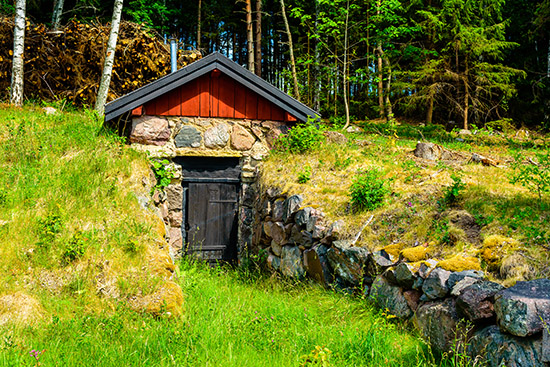
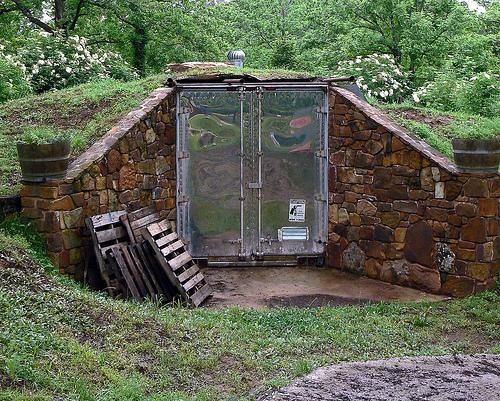







COMMENTS(2)
Hi. We have built a cold storage room in the basement of a barn. My Father put up insulation sheets and covered it with plywood to prevent denting. The other side is spray-foam insulated from 20 years ago. Now there is a smell inside. How to I protect my food from absorbing that smell? Will it harm the produce? I’ve thought of painting the wood to seal in the smell with a low VOC odourless primer. Thoughts?
The floor is concrete